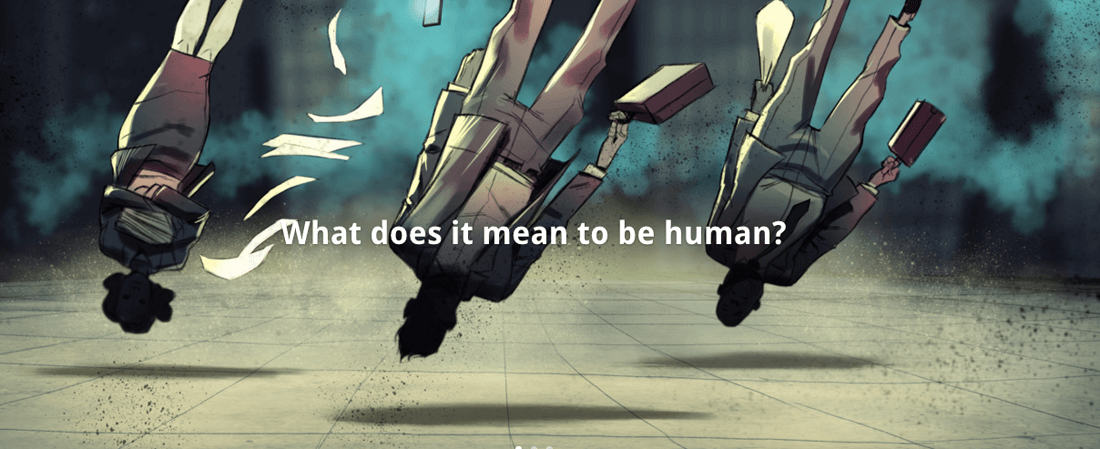Words by Polly Bindman

Stour Space, located in a formerly disused building in Hackney Wick, is from the outside fairly nondescript – a seemingly unlikely location for this year’s London edition of Art Futura festival, which showcases a series of international projects across New Media, Virtual Reality, Interactive Design and Digital Animation. The two live performances at the end of the premier night enjoyed a similarly dissonant relationship between form and content – with both artists utilising simple systems to generate complex sound and light compositions.
This year’s theme of Art Futura is Humanized Technology, a theme which was played out initially in a selection of the most impressive works of the program. Throughout this series of incredible animations, the stand-out motif of the human body was presented in unimaginable and innovative ways – bodies as amorphous, mobile, suspended – bodies of the future remoulded and interspersed onto vast landscapes and desolate wastelands.
More specifically, some of the standout pieces that feature the posthuman body include Dmitry Zakharov’s eerie animation titled ‘Clones performing Michael Jackson’s thriller dance’, and Simon Christoph Kren’s ‘Parasitic endeavours’, which features fleshy, deconstructed human body parts, writhing and wriggling on top of each other as if made of rubber.
Following this selection of clips, Art Futura took us behind the scenes of a few films that have graced our screens in recent years – including Wes Anderson’s Isle of Dogs and Jurassic World. Seeing these films broken down this way is fascinating and indicates the kind of work at the forefront of mainstream animation.
In the second part of the evening, we were privileged to hear a talk by light sculptor Paul Friedlander. Born in the Space Age, Friedlander was a trained physicist before becoming an artist, ever since the Kinetics show fired his imagination at the Hayward Gallery in the 1970s.
Friedlander recounted how once he realised he could build a ‘spaceship for the imagination’, he embarked on a series of experiments under the concept of cybernetic art – art controlled by computers: ‘I can’t exactly solve the wave/particle matter, but I can invite people to reflect on it.’
This quote relates to Friedlander’s discovery that he was working with waves – after some experiments with distorted lenses. His early projects used incredibly basic technology, like polystyrene granules powered by air – a ‘magic fountain.’ In this sense, he sees his work as a kind of research project.
As we saw later in the evening, Friedlander’s work in action is mesmerising. On a small scale, Friedlander can manipulate startlingly simple tools to create pieces with a supernatural quality; motion is central to Friedlander’s work, and many of the images you’ll find of them do little justice to his performances.
Location is also important to Friedlander, who has worked in several impressive locations, including the Jerusalem Archeological Park and the Porta Ticinese gate in Milan. The contrast between the ephemeral flickerings of the extraterrestrial that are evoked in Friedlander’s work and the solid, ancient buildings against which they are set evokes a strange sense of timelessness – an idea Friedlander has explored elsewhere in his work.
Closing the evening was a live performance by Claude Heiland-Allen – a London-based artist interested in the complex emergent behaviour of simple systems. Clive conducted this performance – Claude’s ‘audio live-coding skeleton’, which generated increasingly complex sound compositions as he altered the file in front of us using a text editor, timed to allow the new code to come out in sync. Both of the performances were in some ways sloppy or rough – mistakes were made and, in contrast with the animations at the start of the evening, felt anachronistic.
The way in the artists used the medium of live performance to reveal the deconstruction of complex systems, as well as the reconstruction of simple systems into something more complex, was fascinating. Slick animations complemented Friedlander’s heavier machinery, showing the enormous potential of technology when it is mediated through art and when artists interact creatively with new and pre-existing systems to push art to new limits.
Most importantly, the works shown at this year’s premier gave a sense that in the hands of creatives, there is a space for the human body within technological development. As the body is both augmented by and augments technology, a harmonious relationship can be established between the two.






